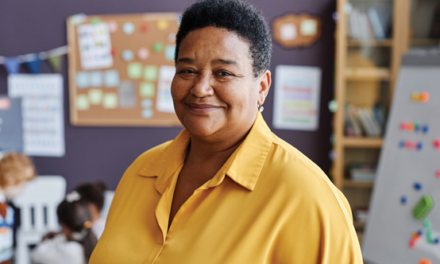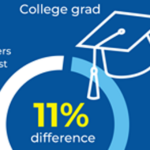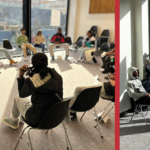
A surge of young, unaccompanied immigrants is met with a broad range of programs intended to salve the effects of trauma, heal family relationships, and help with immigration legal issues.
Not long ago, Mayra, we’ll call her, came to the U.S. from El Salvador determined to succeed. Her mother and father back home suffered from alcoholism, and she had witnessed domestic violence and suffered sexual abuse. In the U.S., she first lived with an aunt and then an older sister, where she faced further emotional and physical abuse. She was not deterred and refused to return to El Salvador.
Mayra moved again and found stability with another older sister and brother-in-law. She worked hard to learn English and earn good grades. She couldn’t shake the anger and sadness from all that she had faced in the U.S. and in El Salvador. She struggled with a temper that got in the way of relationships at school and at home. She participated in group counseling with other newcomer students and began to open up about her past experiences. She also participated in individual counseling to address sexual trauma. She joined a swim team and found the physical exercise and camaraderie to be calming and supportive. She found solace in music and writing poetry, too. Now 16 and in the 9th grade in a school in the Los Angeles Unified School District (LAUSD), Mayra dreams of becoming a nurse, getting married, and building a family of her own someday.
In a one-year period — from September 2013 to September 2014 — the U.S. border patrol detained about 68,000 unaccompanied minors, a 77% increase from the previous year.
Mayra is not alone. In a one-year period — from September 2013 to September 2014 — the U.S. border patrol detained about 68,000 unaccompanied minors, a 77% increase from the previous year. Three-quarters came from Guatemala, Honduras, and El Salvador, countries ranked among the most violent in the world (Collier, 2015). The recent crisis of unaccompanied minors in the U.S. has sparked a need for schools to adapt practices and policies to ensure newcomers adjust and achieve. It is not possible to determine the number of unaccompanied minors in LAUSD because a combination of federal, state, and local guidelines require LAUSD to enroll all students regardless of their immigration status.
LAUSD school social workers say that newcomer students have told of many types of trauma they have endured:
- Newly arrived students have witnessed gang members beating up and killing people in their neighborhoods in their native countries.
- One mother sent her son to the U.S. because of threatening notes from gang members who warned her son about the dangers of not joining a local gang, with words that included “this is your last warning.”
- During la crusada (crossing the border), some students reported being sexually harassed and assaulted by coyotes (adults paid to get children across the border).
- One female student said she was raped by multiple gang members and left for dead. She asked her aunt to send her to the U.S. to avoid death.
- Many students come to the United States to live with family members who they don’t really know. They often feel alone, sad, isolated, and like they don’t fit in.
- Many students experience harassment and discrimination by peers at their new schools.
Welcoming students
Trauma can literally rearrange the brain’s wiring, according to Bessel van der Kolk, a Boston University School of Medicine trauma researcher and neuroscientist (2014); specifically, it affects areas dedicated to pleasure, engagement, control, and trust.
The LAUSD’s role has been to welcome all immigrant students and provide comprehensive academic, health, and social-emotional supports so they can learn and achieve their academic potential. Teachers are accustomed to adapting their classrooms to newcomer students, yet the past couple of years have brought a wave of newcomers who arrive alone from hometowns plagued by violence and gang activity.
LAUSD has long recognized the need to address the mental health needs of its students, opening a mental health department in 1933. The department employs over 300 psychiatric social workers, psychiatrists, and support staff who partner with education professionals. They provide services at schools, wellness centers, special education facilities, and throughout the school district. The mental health department uses an integrated and comprehensive approach that employs universal and targeted — child-specific — remedies. Universal strategies are aimed at all school stakeholders and include teacher and parent training in mental health awareness, psychological first aid, and promoting resiliency and nonviolence among students in their classrooms and homes. Targeted services are designed for early intervention for students who are at risk. These services promote early mental health intervention in schools to foster resiliency and overall wellness so students can learn, grow, and lead productive lives.
Therapies
Intensive services such as individual, group, and family services are offered at mental health clinics or wellness centers with an emphasis on evidence-based, trauma-specific interventions to address significant mental, emotional, and behavioral disorders.
Working in concert with the mental health unit, LAUSD’s Student Enrollment and Placement Assessment Center (SEPA) has been a first stop for students, providing resources to facilitate their enrollment and well-being. Every student throughout LAUSD enrolls at their local designated school. Since downtown Los Angeles has become a concentrated spot for new arrivals, the SEPA Center supports the large number of new arrivals by providing comprehensive physical and mental health services, and linking students to specific resources the student may need from district or external partners. The SEPA center is a supplemental resource to services offered at schools. The SEPA team includes nurses, a psychiatric social worker, an attendance counselor, and interpreter aides. In any given year, the SEPA center assists about 1,400 students who come from all over the world. Yet, in the last year there has been a surge of students who enrolled at the SEPA center after being released from immigration detention centers. Some of the detained students were unaccompanied; others were detained with their parents. (In the 2014-15 school year, the number of students served grew to 2,500.) The youngest student served at the SEPA Center was a 7-year-old traveling across the border unaccompanied. The students and their caregivers need medical services, immunizations, mental health screening and referrals, assistance with school enrollment, and assistance with parent-child relationships after reunification.
A combination of federal, state, and local guidelines require LAUSD to enroll all students regardless of their immigration status.
For example, last year, at the request of one high school principal, LAUSD school-based mental health professionals and graduate social work interns screened 67 newly arrived students for trauma exposure and symptoms. Screening data revealed 97% of the 67 students had experienced one or more stressful life events, in which being separated from a parent was the most commonly reported negative life event. Students, on average, reported six stressful events in their lifetime. Also, 30% of the students reported moderate to severe PTSD symptoms, indicating eligibility for evidence-based, trauma-specific treatment. By comparison, 4% to 6% of children in the general population have PTSD (Kessler, 2012). Trouble concentrating was one of the most common symptoms reported by students.
All of the newly arrived students who were positive for trauma are being treated in a school-based, early-intervention program intended to address the mental health symptoms of youth traumatized by being exposed to a wide variety of violence.
Districtwide, over 1,500 students were screened last school year in LAUSD. School social workers screen students based on risk group (immigrant students), transitional grades (6th grade or 9th grade), or those referred for mental health services by school staff.
The treatment students receive consists of 10 one-hour weekly group sessions for students with moderate to severe PTSD symptoms, one to three individual sessions for students, and one to three parent and teacher group sessions (Jaycox, 2004). Because of the student’s indigent and uninsured status, these services are not billed but absorbed by LAUSD.
Difficulties and improvement
Providing mental health services for this group of students met with some challenges. Guardians of many of the unaccompanied immigrant students were afraid to sign consent forms for trauma screening. Parents were leery of school’s staff — whom they perceived as acting on behalf of the government — coming to their home.
The assurance that we have about supportive interventions making a difference may be found in what some high school students have told us after participating in CBITS:
- I learned that there are other people who have trauma just like me.
- I learned the more you talk about it, the less it hurts.
- The most valuable thing I learned was how strong I am.
- I can be stronger than the memories that bother me and not try to erase them or forget them. I can talk about it now.
In addition to the need for academic and mental health support services provided to newcomer students, there also is a need for school staff and youth-serving agencies to collaborate in offering support to parents and guardians struggling to bond, sometimes for the very first time, with their older children. Parents disclose feeling like they are making a lot of mistakes — for example, threatening to send their children back to their countries of origin as a form of discipline, which only creates further attachment obstacles and emotional wounds. Many biological parents have newly formed families and need support communicating, understanding, and forming healthy attachments.
Legal troubles
Children also are affected by the legal process they endure. Many are detained in refugee centers for up to a year or more. When released, they are assigned a guardian with whom they may have little connection. Those issues are at the core of why LAUSD launched Project Ayuda in early 2015. (Ayuda is Spanish for “help,” and it also is an acronym of the project’s name — Advocating for Youth Unaccompanied in Deportation Actions.) Project Ayuda allows LAUSD attorneys to help unaccompanied youth who live within district borders to find legal representation, or to perform legal representation services themselves on a voluntary basis. At least 150 students have benefited from attorneys’ in-kind services such as navigating their legal status and connecting them to health and mental health services.
LAUSD’s unaccompanied minor immigrant students also find aid through a group of community-based organizations, lawyers, and school staff who sponsor a summer camp aimed to specifically address their social and emotional needs. The camp includes recreational activities as well as counseling and storytelling opportunities in the form of fireside skits written and performed by the students. Such activities are in line with Bessel van der Kolk’s prescription (2014) for treating such trauma, which includes such innovative treatments as neurofeedback, mindfulness techniques, play, yoga, and other therapies.
Today’s immigrants, like so many before them, come seeking freedom, opportunity, and often family. They may arrive penniless and with few possessions. One thing they may bring with them, though, is the long-term, education-stultifying effects of stress-induced PTSD and even depression — the backwash of growing up so close to violence, the natural effect of a difficult trek to the U.S., including months-long detentions, and difficulties when they arrive, the challenges of living life in a new language, confronting reunification with their family or learning to live without their family. Many such students have limited school experience; nonetheless, like Mayra, they have the tenacity to succeed despite their circumstances.
References
Collier, L. (2015, March). Helping immigrant children heal. Monitor on Psychology, 46 (3), 58. www.apa.org/monitor/2015/03/immigrant-children.aspx
Jaycox, L. (2004). CBITS: Cognitive behavioral intervention for trauma in schools. Longmont, CO: Sopris West Educational Services.
Kessler, R.C., Avenevoli, S., & Costello, E. (2012). Prevalence, persistence and sociodemographic correlates of DSM-IV disorders in the national comorbidity survey replication adolescent supplement. Arch GenPsychiatry, 69 (4), 372-380.
Los Angeles Unified School District (LAUSD). (n.d.). Evidence-based programs. Los Angeles, CA: Author. http://bit.ly/1KkLne6
Van der Kolk, B. (2014). The body keeps score. New York, NY: Viking.
Citation: Acuña, A. & Escudero, P.V. (2015). Helping those who come here alone. Phi Delta Kappan, 97 (4), 42-45.
ABOUT THE AUTHORS

Alejandra Acuña
ALEJANDRA ACUÑA is an assistant professor of social work at California State University, Northridge.

Pia Valenzuela Escudero
PIA VALENZUELA ESCUDERO is director of school mental health and crisis counseling and intervention services at the Los Angeles Unified School District, Los Angeles, Calif.










